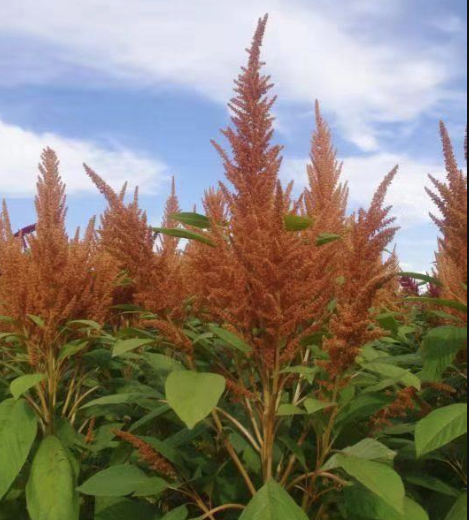运用CHIPS、CUSP和CodonW等程序分析了双子叶C4植物籽粒苋(Amaranthus hypochondriacus)丙酮酸磷酸二激酶(PPDK)基因的密码子偏好性, 并与马铃薯(Solanum tuberosum)和苜蓿(Medicago truncatula)等双子叶植物及水稻(Oryza sativa)和玉米(Zea mays)等单子叶植物进行了比较, 建立了聚类树状图, 以期在作物高光效基因工程中为籽粒苋PPDK基因选择合适的受体植物提供依据。研究结果表明, 籽粒苋PPDK基因偏好于以A或T结尾的密码子, 与其它几种被比较的双子叶作物的PPDK基因密码子偏好性趋势一致, 而玉米和水稻等单子叶植物更偏好使用以G或C结尾的密码子。PPDK基因密码子使用偏好性的系统聚类分析表明, 籽粒苋与马铃薯和苜蓿等双子叶植物聚为一类, 而稗草(Echinochloa crusgalli)、玉米和高粱(Sorghum bicolor)等单子叶植物聚为一类, 与系统进化地位一致。但单子叶植物水稻的密码子偏好性与籽粒苋较为接近, 与玉米和高粱相差较远。为了选择合适的蛋白质表达系统, 比较并分析了籽粒苋PPDK基因的密码子偏好性与大肠杆菌(Escherichia coli)及酵母菌的异同, 发现其与酵母菌的差异小于大肠杆菌, 表明选择酵母菌表达系统更为合适。
We used CHIPS, CUSP and Codon W online programs to confirm the codon bias of the complete coding sequence of PPDK in the grain Amaranthus hypochondriacus, then compared the codon bias with PPDK genes from different plant species. We constructed a phylogenetic tree based on codon bias to provide a basis for selecting appropriate PPDK receptors for A. hypochondriacus by high-photosynthesis gene engineering. PPDK in A. hypochondriacus and several other dicotyledonous crops was biased toward synonymous codons with A and T at the third codon position, but Zea mays, Oryza sativa and other monocotyledons use the end of the G or C codon. Phylogenetic analysis suggested that PPDK of A. hypochondriacus was evolutionarily closer to dicotyledons such as Solanum tuberosum and Medicago truncatula than the monocotyledons Z. mays, Sorghum bicolor and Echinochloa crusgalli. However, O. sativa is an exception in that the codon bias of PPDK is closer to that of dicotyledons A. hypochondriacus than the monocotyledons Z. mays or S. bicolor. To select the appropriate protein expression system, we compared the PPDK codon bias expression in A. hypochondriacus and Escherichia coli or yeast. Differences between A. hypochondriacus and yeast expression were less than between A. hypochondriacus and E. coli. The yeast system may be more suitable for expressing PPDK of A. hypochondriacus.

参考文献
[1] Pocalyko DJ,Carroll LJ, Martin BM, Babbitt PC, Dunaway-Mariano D. Analysis of sequence homologies in plant and bacterial pyruvate phosphate dikinase, enzyme I of the bacterial phospoenolpyruvate: sugar phosphotransferase system and other PEP-utilizing enzymes. Identification of potential catalytic and regulatory motifs. Biochemistry, 1990, 29(48): 10757–10765.
[2] Matsuoka M. The gene for pyruvate orthophosphate dikinase in C4 plants: structure, regulation and evolution. Plant Cell Physiol, 1995, 36: 937-943.
[3] Ryslava H, Muller K, Semoradova S, Synkova H, Cerovska N. Photosynthesis and activity of phosphoenolpyruvate carboxylase in Nicotiana tabacum L. leaves infected by Potato virus A and Potato virus Y. Photosynthetica, 2003, 41: 357-363.
[4] Moons A, Valcke R, Van Montagu M. Low-oxygen stress and water deficit induce cytosolic pyruvate orthophosphate dikinase (PPDK) expression in roots of rice, a C3 plant. Plant J, 1998, 15: 89-98.
[5] Yamakawa H, Hirose T, Kuroda M, Yamaguchi T. Comprehensive expression profiling of rice grain filling-related genes under high temperature using DNA microarray. Plant Physiol, 2007, 144: 258-277.
[6] 杜西河,许为钢,胡琳,张磊,李艳,齐学礼,王会伟,王玉民. 转ZmPEPC与ZmPPDK基因拟南芥对干旱胁迫的反应.分子植物育种, 2013, 11(4): 477-484.
[7] Li J, Xue Z. Comparison of MADS transcriptional factor on codon bias in arabidopsis and rice.J Zhejiang Univ Agric Life Sci, 2005, 31(5): 513-517.
[8]吴宪明,吴松锋,任大明,朱云平,贺福初. 密码子偏性的分析方法及相关研究进展. 遗传,2007.29(4):420- 426.
[9] 郭秀丽, 王玉, 杨路成, 丁兆堂. 茶树CBF1基因密码子使用特性分析. 遗传,2012,34(12): 1614-1623.
[10]李平,白云凤,冯瑞云,王原媛,张维锋. 籽粒苋苹果酸酶(NAD-ME)基因密码子偏好性分析.应用与环境生物学报, 2011, 17(1): 012-017.
[11] Wang LJ, Roossinck MJ. Comparative analysis of expressed sequences reveals a conserved pattern of optimal codon usage in plants. Plant Mol Biol, 2006, 61: 699–710.
[12] Sharp PM, Li WH. An evolutionary perspective on synonymous codon usage in unicellular organisms. J Mol Evol, 1986, 24 (1-2): 28-38.
[13] Sharp PM, Cowe E, Higgins DG, Shields DC, Wolfe KH, Wright F. Codon usage patterns in Escherichia coli, Bacillus subtilis, Saccharomyces cerevisiae, Schizosaccharomyces pombe, Drosophila melanogaster and Homo sapiens: A review of the considerable within species diversity. Nucl Acids Res, 1988, 16 (17): 8207-8211.
[14] Sau K, Gupta SK, Sau S, Ghosh TC. Synonymous codon usage bias in 16 Staphylococcus aureus phages: Implication in phage therapy. Virus Res, 2005, 113 (2): 123-131.
[15] 顾万君,马建民,周童,孙啸,陆祖宏. 不同结构的蛋白编码基因的密码子偏性研究. 生物物理学报,2002,18 (1): 81-86.
[16] Zhou H, Wang H, Huang LF, Naylor M, Clifford P. Heterogeneity in codon usages of sobemovirus genes. Arch Virol, 2005, 150 (8): 1591-1605.



